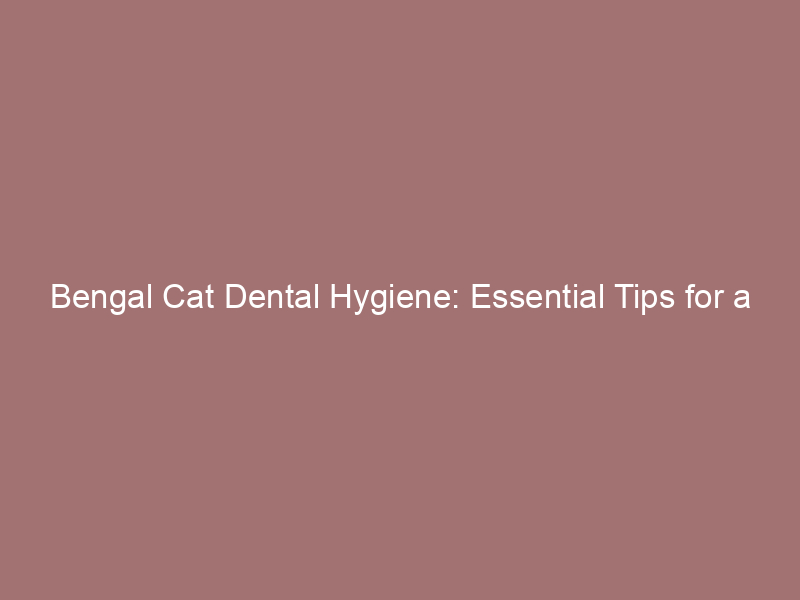
Introduction to Bengal Cat Dental Hygiene
- Importance of Bengal cat dental care
Good dental care helps your Bengal cat live a long and happy life. Without it, your cat can suffer from pain and other health problems. Regular dental care can prevent issues like bad breath, tooth decay, and gum disease.
-
Common Bengal cat dental issues
- Gingivitis: This is when the gums become red and swollen. It can be painful for your cat.
- Periodontal disease: This is a serious gum infection that can damage the teeth and bones.
- Tooth resorption: This is when the tooth starts to break down and dissolve.
Bengal Cat Oral Health
Characteristics of Bengal Cat Teeth
- Number and types of teeth: Bengal cats, like most domestic cats, have 30 teeth. These include incisors, canines, premolars, and molars. Each type of tooth has a specific function. Incisors are small and help with grooming. Canines are sharp and used for catching prey. Premolars and molars are for chewing food.
- Unique dental features in Bengal cats: Bengal cats have strong jaws and sharp teeth, which help them eat meat. Their teeth are designed to tear and chew food efficiently. Bengal cats also have a unique dental structure that helps them keep their teeth clean naturally. However, they still need regular dental care to prevent problems.
| Type of Tooth | Function |
|---|---|
| Incisors | Grooming and nibbling |
| Canines | Catching and holding prey |
| Premolars | Chewing and tearing food |
| Molars | Grinding food |
Common Bengal Cat Dental Problems
- Gum Disease: Gum disease, also known as periodontal disease, is a common issue in Bengal cats. It starts with plaque buildup on the teeth, which can lead to inflamed gums. If not treated, it can cause pain and tooth loss. According to Wikipedia, gum disease affects many pets and can be prevented with regular dental care.
- Plaque and Tartar Buildup: Plaque is a sticky film of bacteria that forms on the teeth. If not removed, it hardens into tartar. This can lead to bad breath and more serious dental problems. Regular brushing and dental treats can help reduce plaque and tartar buildup.
- Tooth Decay: Tooth decay, or cavities, can occur when bacteria in the mouth produce acids that erode the enamel. This can cause pain and infection. Providing a balanced diet and regular dental check-ups can help prevent tooth decay in Bengal cats.
Bengal Cat Teeth Cleaning
How to Brush a Bengal Cat’s Teeth
- Choosing the right toothbrush: Use a toothbrush made for cats. These are smaller and softer than human toothbrushes. You can find them at pet stores or online. A finger brush is also a good option for beginners.
- Proper brushing technique: Start by letting your cat get used to the toothbrush. Let them sniff and lick it first. Then, gently lift your cat’s lip and brush in small circles. Focus on the gum line where plaque builds up. Brush for about 2 minutes, and be gentle to avoid hurting your cat.
Bengal Cat Plaque Removal
- Use of dental chews: Dental chews can help remove plaque from your Bengal cat’s teeth. They work by scraping off the plaque as your cat chews on them.
- Professional dental cleaning: A vet can perform a thorough cleaning of your cat’s teeth. This usually involves removing plaque and tartar buildup.
- Regular dental check-ups: Regular visits to the vet can help catch dental issues early. Aim for at least one check-up per year.
- Diet and nutrition: Feeding your Bengal cat a balanced diet can promote good dental health. Look for foods that are designed to reduce plaque.
- Changes in eating habits: If your cat starts eating less or has trouble chewing, it could be a sign of dental problems. Consult your vet if you notice these changes.
- Bad breath: Bad breath can be a sign of plaque buildup or other dental issues. If your cat’s breath smells bad, it’s time for a dental check-up.
- Visible plaque or bleeding gums: Check your cat’s mouth for visible signs of plaque or bleeding gums. These are indicators that your cat needs dental care.
- Recommended toothbrushes and toothpaste: Use a toothbrush and toothpaste made specifically for cats. Human toothpaste can be harmful to them.
- Effective dental chews: Look for dental chews that are approved by vets. These chews are designed to help clean your cat’s teeth effectively.
- Specialized cat food for dental health: Some cat foods are formulated to promote dental health. These foods can help reduce plaque and tartar buildup.
- Preparing your Bengal cat: Before brushing your cat’s teeth, make sure they are calm and comfortable. This will make the process easier for both of you.
- Applying toothpaste: Apply a small amount of cat toothpaste to the toothbrush. Let your cat taste it first to get them used to the flavor.
- Brushing technique: Gently brush your cat’s teeth in a circular motion. Focus on the gum line where plaque tends to build up.
- Post-brushing care: After brushing, reward your cat with a treat or some playtime. This will help them associate tooth brushing with positive experiences.
- Importance of regular vet visits: Your vet can provide professional cleanings and check for any issues.
- What to expect during a dental check-up: During a dental check-up, the vet will examine your cat’s teeth and gums. They may also take X-rays to check for hidden problems.
Recap of Bengal cat dental care tips: Use dental chews, brush their teeth regularly, and visit the vet for check-ups. A balanced diet also helps maintain dental health.
Long-term benefits of good dental hygiene: Good dental hygiene can prevent serious health issues. It can also improve your cat’s overall well-being and quality of life.






